Updated October 28, 2019
How do you find Aeroplan flights? If you punch in your round-trip or multi-city destination and dates, chances are you’ll be offered unappealing flights with hefty taxes and fees.
There’s a better way. Get behind those initial offerings to find the nuggets in the Aeroplan inventory. They’re there. Finding them takes time, and a little Aeroplan know-how.
Ready to get started? Good. I’m currently searching for spring flights from Canada to Europe. I’ll use my trip as a case study to illustrate the steps I generally follow to redeem Aeroplan miles.
NOTE: The following case study applied to the Aeroplan program before it was revised in November 2020. While certain features of the program have changed (e.g., no more fuel surcharges, changed stopover rules, and an amended award chart), many of the steps and tools used to find Aeroplan flights are applicable to the new program.
Table of Contents
- Case Study
- Finding Aeroplan flights: a step-by-step guide
- Step 1: Gather your tools
- Step 2: Think about what your flights are worth
- Step 3: Know how your costs add up
- Step 4: Picture your trip in segments
- Step 5: Keep MPM in mind
- Step 6: Know your departure airport’s airlines
- Step 7: Identify routes from your destination
- Step 8: Conduct a search of the “end” segment
- Step 9: Research availability on the first segment
- Step 10: Research the ‘middle’ segments
- Step 11: Join the ‘beginning,’ ‘middle,’ and ‘end’ segments
- Step 12: Rinse and repeat
- Tips
- Acknowledgement
Case Study
Case Study: It’s now December 2017. I’ll be travelling to Europe between mid-March and mid-April of 2018.
My home airport is Halifax. I’ll be visiting Malta and Italy. I’m leaning towards an “open-jaw” redemption. This involves flying into one airport, and returning from another. In my case, it would mean flying into Malta, and flying home from Italy. According to Aeroplan rules in effect at the time, an open jaw between two continents allowed for one stopover. A stopover is an advantage if you’d like to take a rest from a long flight. Or, perhaps you’d like to visit another place on the way out, or on the way back. It’s also useful if you’d like to extend your stay in a city where you’re forced to stay overnight. Onward flights aren’t always available at convenient times.
At the time, Malta was in the Europe 2 zone. It cost 75,000 miles to travel in economy, or 90,000 miles in premium economy. Business class cost 115,000 miles, and 160,000 miles were needed for first class.
Finding Aeroplan flights: a step-by-step guide
Step 1: Gather your tools
Having access to the right tools will save you money and time. Here are the ones I currently use.
- Mileage chart. The Aeroplan Flight Rewards chart shows how many Aeroplan miles you’ll need if you’re using Fixed Mileage Flight Rewards. They’re categorized by destination, and choice of cabin.
- Your Aeroplan account. You’ll need to log in to your online account to search for possibilities. If you’ll be travelling on another person’s miles, you’ll need to be an authorized user on that account.
- Aeroplan Contact Centre. Program the toll-free number into your phone (1-800-361-5373). Set up your Contact Centre PIN. Enter your Aeroplan number at the beginning of the call.
- Map. A map shows your destination and what’s nearby. Google Maps is a good choice. Ground transportation, budget airlines, or other frequent flyer programs could be used in tandem with your Aeroplan redemption.
- Calendar. Hopefully, you have flexibility with dates. Some airlines don’t have daily flights on some routes. Weekend schedules and award availability can be different from what’s offered during the week.
- Your other frequent flyer programs. These might help you get to a hub offering an attractive Aeroplan redemption. It’s also an opportunity to integrate another stopover. Air Miles? Use it as a secondary program to reach a hub, and enjoy another “stopover.” British Airways’ Avios? Avios miles are excellent for short-haul flights with OneWorld airlines.
- Your hotel loyalty programs. Award travel often requires overnight accommodation en route.
- FlightConnections. This is an excellent tool for identifying airline routes. Use the Star Alliance filter to narrow your search. An attractive feature of FlightConnections is that it shows which days of the week an airline offers flights.
- Great Circle Mapper. Use Great Circle Mapper to calculate the total mileage of your award flights.
- List of airlines serving your departure airport and nearby hubs. Getting to know the routes of the airlines will save you lots of search time. Create a “semi-permanent” record showing routes, and usual flight times.
- IATA codes. Get to know the airport codes, and use them when searching and recording your results. It’ll save you time. It will also reduce the possibility of mistakes involving cities with more than one airport.
- Flight search sites. Know the value of a revenue ticket. A good starting point is Google Flights. Google Flights can also be used to research routes, using the Star Alliance filter.
- SeatGuru. Where you have choices of routes and airlines, the seat maps at SeatGuru might help you decide. It’s also useful for getting a picture of unfamiliar aircraft. In the case of smaller regional planes to and from a major hub, it’s a quick way to confirm whether or not there’s a business class cabin.
- Recording tools. You’ll need to keep track of your research. Spreadsheet? Pen and paper? To avoid a disorganized mess of assorted notes, I’ve developed a couple of tables in MS Word.
Step 2: Think about what your flights are worth
When it comes to air travel, how do you determine ‘worth?’ How much emphasis do you place on monetary value? How much value do you attach to convenience, such as friendly departure, arrival, and connecting times? What’s it worth to you to have access to premium seating and airline lounges? What value do you place on the ability to add stopovers, as allowed by Aeroplan’s stopover rules?
What are the costs, flight times, and benefits of an economy class revenue ticket? Are seat selections per segment included in the price? What are the costs and benefits of a business class ticket on the same route? Is the free carry-on allowance 7 kg, 8 kg, or 10 kg? What are the allowances and fees for checked baggage? What are the change and cancellation fees?
The more information you gather will position you to choose between a revenue ticket and an award ticket. All things considered, you might decide that it’s better to save your Aeroplan points for future travel.
Case Study: Do I burn 115,000 miles for the luxury of business class? Or, do I redeem 75,000 miles for an economy class ticket, and use the other 40,000 miles for a future trip to Central America? Or, will I pay cash, and save the miles? A ticket from Halifax to Malta, and Rome to Halifax costs a minimum of $1072 in economy class. It costs at least $4905 in business.
Step 3: Know how your costs add up
Award travel isn’t free. Costs consist of the following:
Aeroplan points
Aeroplan points are a travel currency. They depreciate with time.
How are Aeroplan points valued? Some people use various approaches to create a ‘cents-per-mile’ (CPM) value. Others work from the perspective that the more an equivalent revenue ticket costs, the more value you’re getting from your miles. This is why many miles-and-points enthusiasts use them for business or first class travel.
Booking fee
If you’re able to book online, there’s no fee. The Aeroplan site can handle more complicated searches, but it doesn’t have the capacity to book them. For these, you need to book through an agent. The service fee is $30 plus tax.
Taxes, fees and surcharges
When you search on Aeroplan, you’ll see an itemized list of the taxes, fees and surcharges. It appears in the search results if you click on > DETAILS > SELECT > Taxes, fees & surcharges.
Fuel surcharges
Fuel surcharges appear as ‘carrier surcharges.’ In points-and-miles circles, they invoke reactions ranging from distaste to disgust. They’re commonly referred to as ‘scam charges.’ In the industry, they’re known, and coded, as ‘YQ/YR’ charges. For the most part, they’re avoidable. Avoid flying on airlines that have them. Or, fly through countries that regulate them.
Air Canada has fuel surcharges. Depending on where you live, it might be impossible to avoid Air Canada. If so, use Air Canada only for your first and last flights to and from a nearby hub within North America. (Or, fly Air Canada when they come under the restrictions imposed by countries that regulate fuel surcharges.)
From the hub, look for a Star Alliance airline without fuel surcharges. That way, the fuel surcharges due on the Air Canada segment(s) either disappear or are reduced to $15.
Here’s an example, using Istanbul to Halifax via Toronto.
The Toronto to Halifax segment with Air Canada attracts a fuel surcharge of $42. The total in taxes, fees and surcharges amounts to $83.76.
When Aeroplan joins the two segments (Istanbul to Toronto on Turkish Airlines, Toronto to Halifax on Air Canada), the fuel surcharge disappears. You’ll also notice that taxes and fees are reduced to $23.62.
Taxes and fees
These are unavoidable. They include government-imposed charges for services such as airport security and navigation, or to fund airport improvement. But, they can be minimized.
Where desirable, choose airports and countries with low taxes and fees. As you saw in the screenshots above, Istanbul has a “Turkey International Airport Service Charge” of $19.10. That’s the extent of the taxes and fees when departing from Istanbul. On the other hand, departing from Heathrow on the same date to the same destination costs $340.30 ($264.30 + $76.10). With Air Canada’s fuel surcharge of $244.80, the total in taxes, fees and surcharges is a whopping $585.20.
Some countries have lower taxes and fees, compared to others. For example, travelling through Germany, compared to Switzerland, will attract higher taxes and fees.
Case Study: I’m leaning towards business class. I detest fuel surcharges. To minimize them, I’ll need to get behind the noise of so many Air Canada and Lufthansa flights in the Aeroplan inventory. I’ll focus on routes served by airlines without fuel surcharges. These are Brussels, SAS, SWISS, TAP Portugal, Turkish Airlines, and United. I’ll avoid connections through Germany, unless a stopover in Munich takes my fancy. I love Turkish Airlines. However, given that my destination is Malta, I might run into trouble with MPM by flying to Istanbul and backtracking to Malta. That needs to be checked.
Step 4: Picture your trip in segments
Many successful redemptions involve searching in segments. Think of segments as having a beginning, an end, and those in between. Or, picture them as a one-way string of flights from your departure airport to your destination. Visualize a similar sequence of separate flights for the trip home.
Step 5: Keep MPM in mind
MPM stands for ‘Maximum Permitted Mileage.’ For an itinerary to be valid, the total distance of your award ticket must be within Aeroplan’s MPM limit. If your routing exceeds Aeroplan’s MPM value, their system can’t book your trip. By applying an MPM lens to your searches, you can avoid wasting time on unbookable itineraries.
If you fall within the following groups, you need to keep MPM in mind:
- Part of your journey requires flying in the opposite direction to your destination in order to reach a major hub.
- Your destination has limited service, and you need to be creative in finding indirect routes. It might require overshooting your destination and backtracking, or zigzagging to find a route.
- You want to add a stopover that deviates from a relatively straight line to your destination.
- You like to find MPM sweet spots, and push the limits on squeezing the greatest distance possible from the award chart.
- You’re searching for a round-the-world redemption.
Early in your search, some obvious routes will start to appear. To find out if they’re viable, calculate their total mileage using the tool Great Circle Mapper. Insert a string of airport codes of a likely itinerary in the search box, separating each one with a hyphen. Click on either the Map or the Distance button to reveal the total mileage.
To find Aeroplan’s MPM from your point of departure to your destination, call the Aeroplan Contact Centre. Or, conduct a dummy search of flights to your destination. Any one of these three posts will describe how to do it:
- Finding Aeroplan MPM Online Easily!
- How to Find the Aeroplan MPM Online
- How to Find Aeroplan’s Maximum Permitted Mileage (MPM) Value
Case Study: Minimizing fuel surcharges on routes to Europe, from Halifax, usually requires backtracking to Montreal or Toronto. In addition, there are a limited number of routes serving Malta. For example, there’s a ‘zigzag’ route via Copenhagen or Stockholm, or a ‘backtrack’ route through Istanbul. These factors can lead to MPM issues.
As you can see from the above screenshot, a Halifax-Toronto-Istanbul-Malta itinerary has a total distance of 6764 miles. This exceeds Aeroplan’s MPM of 6624 for Halifax to Malta. This was the value I obtained from an agent at the Aeroplan Contact Centre. The dummy search described in the posts above revealed an MPM value of 6614. Close enough. If in doubt, speak to an Aeroplan agent before wasting time on an invalid itinerary.
Changing the routing slightly to travel through Boston makes a difference. A Halifax-Boston-Istanbul-Malta route reduces the mileage to 6097. Also, if I want to travel through Copenhagen or Stockholm, I’ll need to connect through Boston. Connecting through Toronto will likely exceed the MPM. Zurich is on a relatively straight line between Eastern Canada and Malta. So it’s unlikely I’ll run afoul of Aeroplan’s MPM by connecting through Zurich.
Step 6: Know your departure airport’s airlines
Which Star Alliance airlines, without fuel surcharges, serve your departure airport? Where do they fly?
For example, United connects Edmonton and Houston. There’s a direct flight from Vancouver to San Francisco or Chicago with United. EVA Air offers a direct flight from Toronto to Taipei. From Montreal, you can fly SWISS to Zurich, Air China to Beijing, and Turkish Airlines to Istanbul.
Keep a semi-permanent record of the airlines, routes, flight schedules and usual departure times. I use a printable table for this purpose. It makes searches more focused, and saves lots of time. My go-to tools are FlightConnections and Google Flights. Use the built-in filters such as ‘Star Alliance’ on FlightConnections, and ‘direct flights’ on Google Flights.
It’s important to know flight schedules. Why spend time searching for availability for an airline that doesn’t fly every day? For example, earlier this month I enjoyed a wonderful Air China flight from Havana to Montreal. It had just one flight a week on this route: a “fifth-freedom flight” from Havana to Beijing with a stop in Montreal. Knowing this saves a pile of research time. My go-to tool for this “Intel” is FlightConnections.
However, if you find a route with loads of potential, don’t rely on FlightConnections. The information could be outdated. Just in case, check Aeroplan availability on other dates.
Case Study: United is the only Star Alliance airline, without fuel surcharges, flying out of Halifax. It offers a direct flight to Newark, New York on a small aircraft offering economy class only.
I also maintain a record of airlines without fuel surcharges serving Montreal, Toronto and Chicago. More often than not, these are my go-to hubs for Aeroplan redemptions. Boston is another option, using Air Canada’s direct flight from Halifax. It, too, uses a small plane with economy seats only.
Step 7: Identify routes from your destination
Yes, ‘from’ isn’t a typo. Let’s work backwards, by exploring options for the ‘end’ segment. This is especially important for an unfamiliar destination (such as Malta, for me). It might not be served by a Star Alliance airline. Or, it might be an airline with fuel surcharges. If so, you’ll need to know what’s the closest hub.
My favourite tool is FlightConnections. Click on the airline alliance filter and select ‘Star Alliance.’ Enter your destination to generate the map showing the routes with direct flights. Click on each connecting city to find out which airlines operate on that route, and which days of the week they offer service.
Case Study: There are direct flights to Malta from Stockholm (SAS), Copenhagen (SAS), Frankfurt (Lufthansa), Munich (Lufthansa), Zurich (SWISS), Athens (Aegean), and Istanbul (Turkish Airlines). Of the five airlines serving these routes, only one has fuel surcharges (Lufthansa).
Step 8: Conduct a search of the “end” segment
Segment searches reveal availability. Each option displays flight times, cabin, and type of aircraft. Also, it gives some idea of what taxes, fees and surcharges might be due on the entire trip.
The other great thing about segment searches is that they reveal the possibilities for stopovers.
Visit the Aeroplan site and conduct segment searches of routes revealed in the previous step. Record the results of your research in case you need to search over several sittings. Going over the same ground a second or third time will drive you crazy. Figuring out your recording tools is an important piece of award travel.
Case Study: It became clear that Zurich and Istanbul were my best options. Copenhagen was a possibility. The end segment looked like Zurich to Malta with SWISS, Istanbul to Malta with Turkish Airlines, or Copenhagen to Malta with SAS.
Zurich to Malta seemed the most viable. That’s where I started, using a search window of Sunday to Saturday. I recorded availability in the bottom section of my three-segment table. The other two sections were kept vacant for connecting segments.
Step 9: Research availability on the first segment
Revisit the possibilities described in Step 6. If you have a good handle on the choices from your home airport, you’ll know where to start.
Case Study: With my ‘semi-permanent’ picture of routes from my home airport and nearby hubs, the connections with the ‘end’ segment became obvious. With my MPM dilemma, Halifax to Boston became an attractive ‘beginning’ segment. From Step #6, I know that Boston has direct flights to Copenhagen, Zurich and Istanbul.
In Step #8, I started my segment search with Zurich to Malta. On the same chart where I recorded availability on that route, I recorded Halifax to Boston availability in the top section. This leaves the middle section to record research on the ‘middle’ segment, Boston to Zurich.
My Halifax-Boston research revealed a few options to catch a late afternoon flight. This enables me to make the three-hour drive from home to Halifax, without incurring the costs of overnight accommodation in Halifax. This is a bonus, if there’s availability on the late-night direct flight from Boston to Zurich.
Step 10: Research the ‘middle’ segments
Now it’s time to link the first segment with the end segment (if they don’t already connect). Work forwards or backwards. It’s your choice. However, if there’s more than one middle segment, search for the longer one first, especially if it crosses an ocean. FlightConnections is your friend. Keep your list of Star Alliance airlines handy, specifically those without fuel surcharges.
Case Study: From a previous step, I knew that SWISS flies Boston to Zurich every day. At the Aeroplan site, I searched availability for all days in my 7-day search window. The results were recorded in the middle section of my recording tool. I now had my options for Halifax-Boston, Boston-Zurich and Zurich-Malta recorded on the same one-page chart.
Step 11: Join the ‘beginning,’ ‘middle,’ and ‘end’ segments
If the miles-and-points goddess is in your corner, you’ll have what you need to create a viable outbound itinerary. With options for each segment recorded on the same chart or Excel spreadsheet, you’ll easily see how they might connect.
Case Study: The Halifax-Boston late afternoon departure connected beautifully with the Boston-Zurich overnight flight. Zurich-Malta was a different story. Fortunately or unfortunately, the times were such that an overnight stay in Zurich couldn’t be avoided. I saw it as an advantage, and booked my flights to include a two-night stay in Zurich using Aeroplan’s free stopover rules that were in effect at the time.
Step 12: Rinse and repeat
Now, work on the return leg. If you’re booking a return redemption, start by looking at the same segments you found for the outbound flights. Or, perhaps you’d like to experience different airlines with different aircraft on different routes with different stopovers. In any case, follow the same process described above to construct your string of segments.
Consider stopovers. Check the stopover rules. Since September 2019, between continents you can have one stopover on a return redemption. There’s an expectation that sometime in 2020, Aeroplan will reinstate two stopovers on a return and one stopover on an open jaw.
Case Study: I’ll be in the northern region of Italy. I could leave from Florence, Bologna, Milan or Rome. Or, I could use a budget airline to reach another departure point offering an attractive Aeroplan redemption. I’ve lots of British Airways’ Avios points so that could be a means to reach an attractive departure airport and enjoy a “free stopover.”
I played around with my options and eventually went with an Aeroplan departure from Rome. I found a workable itinerary using Rome-Zurich and Zurich-Montreal with SWISS.
Unfortunately, Air Canada failed to cooperate for the home stretch. This has happened so often that I’ve come to expect it. This is one of the reasons I have miles-and-points envy of friends who live in Vancouver, Calgary, Toronto and Montreal. Despite the availability of direct flights (on revenue tickets and Market Fare Flight Rewards) from Montreal to Halifax, I was forced to do a ‘backwards bunny-hop’ through Ottawa, and incur additional charges. In the past, I’ve been able to find availability by doing wider searches of dummy routes to squeeze out availability for the last critical segment. These sometimes reveal ‘married segments.’ Married segments usually come as a pair and cherry picking one of the segments is rarely bookable. Nothing I tried worked. In my experience, agents at the Aeroplan Contact Centre don’t have access to any more flights than what are available online. Still, it doesn’t hurt to check. As predicted, there was no availability on the last two late-night flights to Halifax. Air Canada will eventually release a Montreal-Halifax direct flight for Fixed Mileage Flight Rewards, but the $100 change fee won’t be worth the change. I’ll keep an eye on it, and call to see if I can get the change fee waived. I don’t like my chances, but it doesn’t hurt to ask.
Taxes, fees and surcharges totalled $234.81, including $30 in fuel surcharges imposed by Air Canada. They’re coded as “YR” in the fare calculation.
Tips
- I hope I haven’t made this sound more complicated than it is. With knowledge of the routes from your home airport and nearby hubs, and doing segment searches to your destination, it’s really not that difficult.
- Develop your own approach to the order of your segment searches. Vary the sequence depending on the destination. Sometimes, it makes sense to begin with a long flight, or one that crosses an ocean. Or, you might want to start with a hub served by an airline with a limited award inventory. That’s how I found Air New Zealand business into Auckland, and then worked forwards and backwards from Shanghai and Auckland.
- Your success rate will increase if you have flexibility with dates and routes.
- Don’t use airlines with fuel surcharges. They don’t deserve our business. If you can’t avoid Air Canada, use it only for short flights to reach a nearby hub in North America (or to countries that regulate fuel surcharges).
- Availability changes. If you see something you like, book it. Otherwise, it might disappear. If you come up empty, return to your search in a day or two.
- If you’re booking through the Aeroplan Contact Centre, do your own research. Have the dates, flight numbers and times ready to ‘feed’ the agent. If you expect the agent to do the research, chances are you’ll end up on flights with fuel surcharges.
- Keep a record. Unless it’s a straightforward redemption you can book online, no one can keep that much information in their head. If you’re comfortable with Excel or a similar program, Points Nerd has a good template. If you’re a pen-and-paper person, use or adapt my printable tools to suit your needs. I’ve added PDF versions to the Resource Library. Scroll down to the bottom of the post to sign up for access, or use the sign-up option in the sidebar.
Acknowledgement
I owe much to several miles-and-points bloggers. They’re my educators and mentors. The more they produce, the more I learn. Check out some of their work. Or, come to the next PointsU conference to meet them, and other miles-and-points enthusiasts, and learn more about the miles-and-points scene in Canada.
- Jayce started Points Nerd. He wrote an excellent five-part series on Finding Award Availability. His five-part series, Tools I Use – Award Flights is a wonderful resource.
- Ricky is the Prince of Travel. Check out his Beginner’s Guide to Redeeming Points.
- Avery has an assortment of Aeroplan articles at Don’t Call the Airline. Use the search feature to find them. In Why Aeroplan’s “Pay with Miles” is a Terrible Joke, he explains why you shouldn’t use miles to cover taxes, fees and surcharges. He also runs a booking service, Awarding Canada.
- Jeff from Canadian Kilometers introduced me to the Great Circle Mapper in his post, Find Aeroplan MPM Online Easily!
Congratulations on making it to the end of such a long post. If you found this guide useful, you might be interested in my other miles-and-points posts:
- Is a no-FOREX-fee credit card always the best choice for international travel?
- Travel the world on miles and points by meeting Minimum Spend Requirements
- What is the best credit card for trip cancellation, trip interruption and flight delay insurance for trips on points?
- Lounge and flight review of United Airlines’ Polaris experience
- What’s the best use of Scene+ (formerly Scotia Rewards) for travelling the world on miles and points?
- Is the TD Rewards program worth it for travelling the world on miles and points?
- Is the BMO Air Miles World Elite MasterCard a good deal?
- Why the Best Western loyalty program is good for travellers
Travel update. A nor’easter almost derailed the trip. Thanks to an itinerary management app, being fully packed the day before, and an agent at the Aeroplan Contact Centre, things unfolded with a few amendments. The agent replaced the economy class flight to Boston with a business class flight to Montreal, and eliminated the bunny hop through Ottawa on the return. You can read about it in This could be the best travel tip you will ever receive.
Care to weigh in? I love hearing from other miles-and-points enthusiasts. Please do so, in the comments. If you’ve made a sweet Aeroplan redemption, or have a link or tips to share, please join the conversation.
Care to share the Pinspiration?

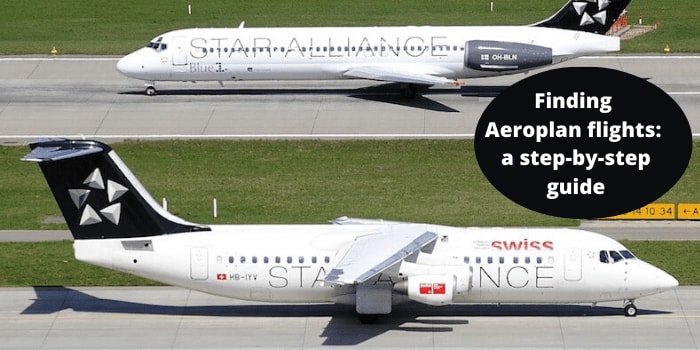

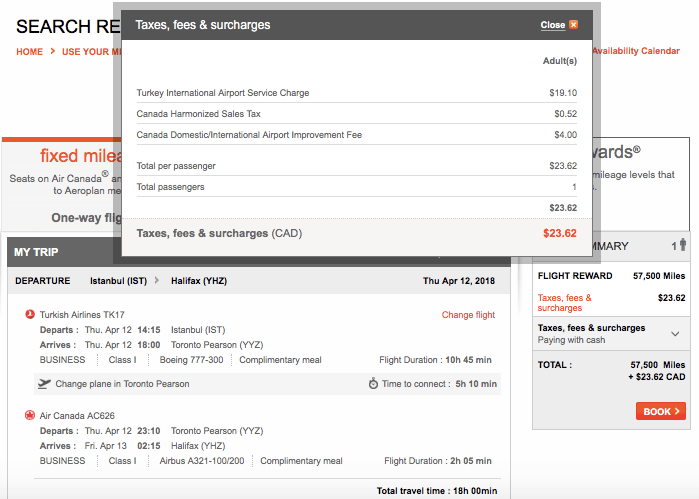
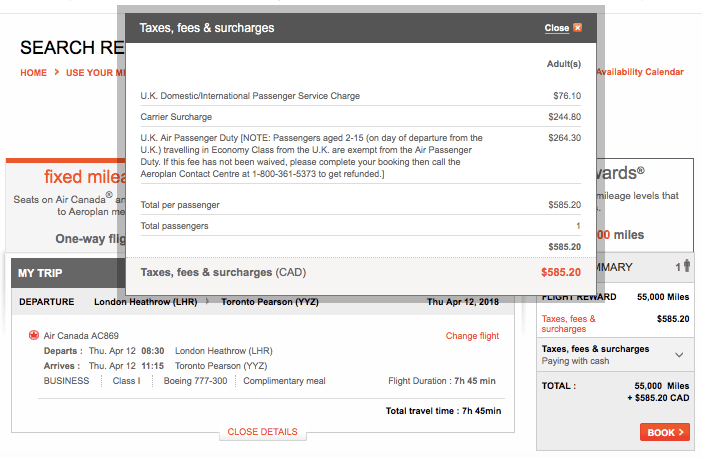
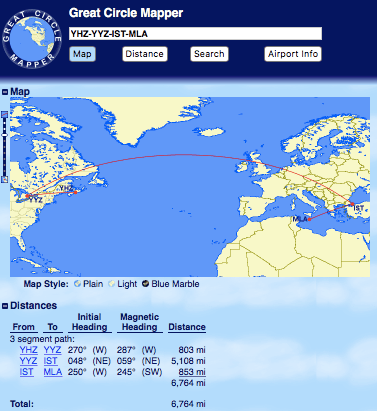

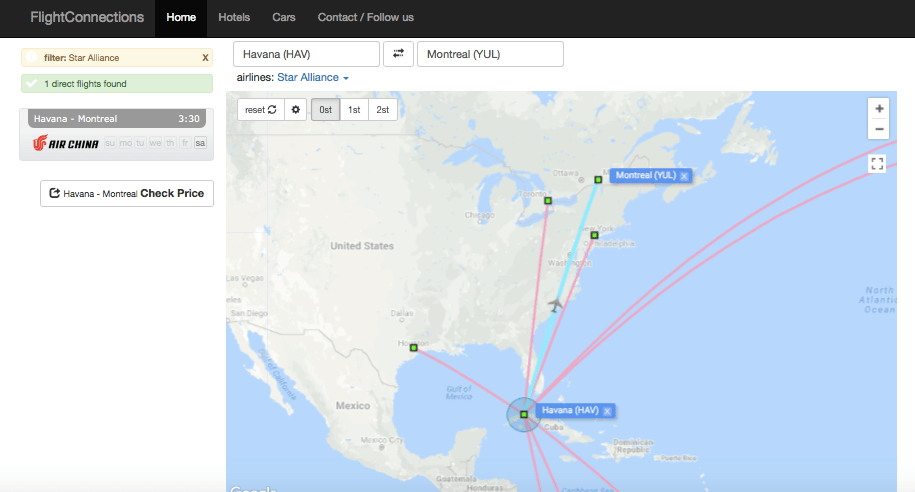
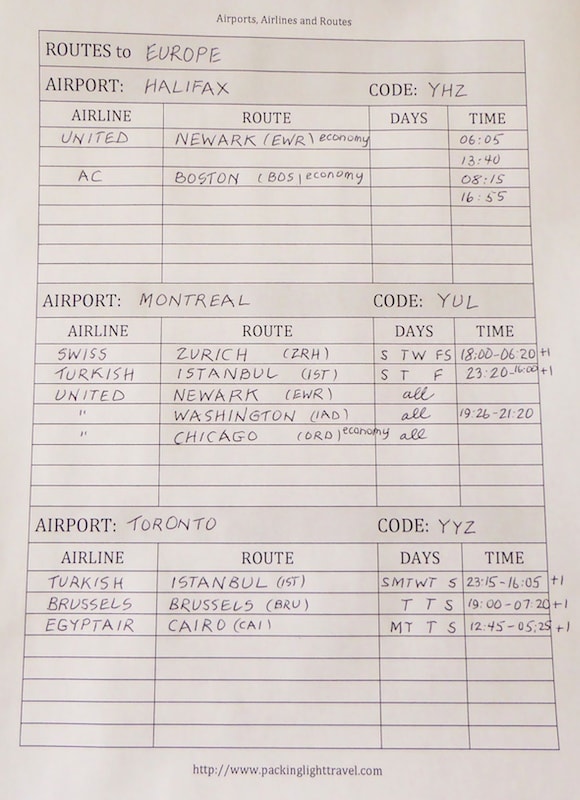
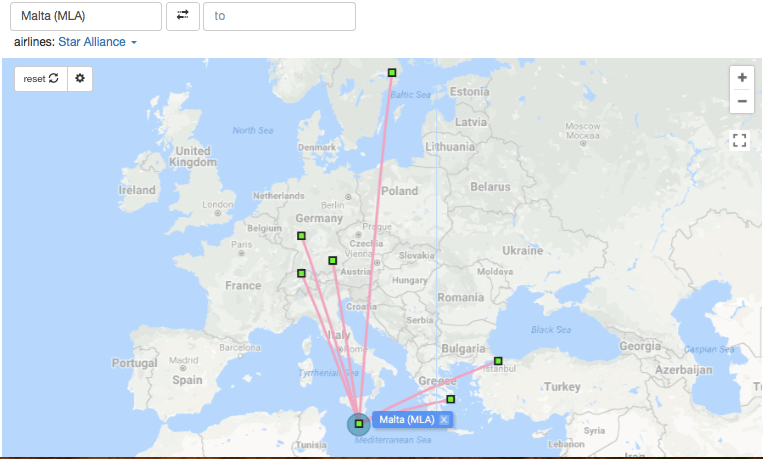

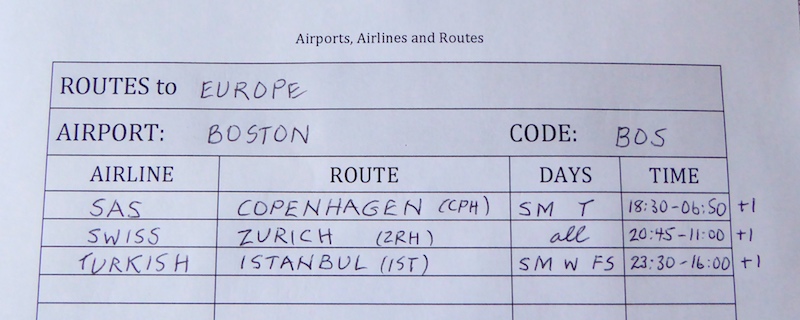
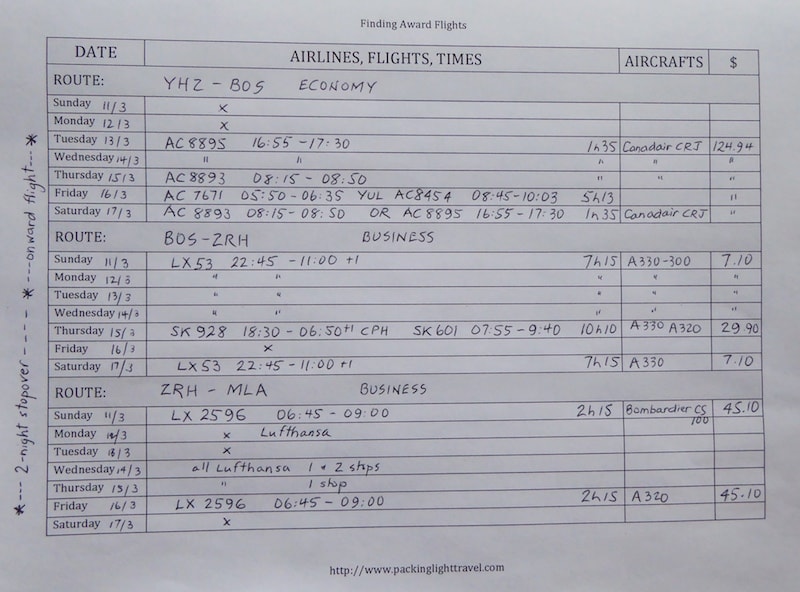
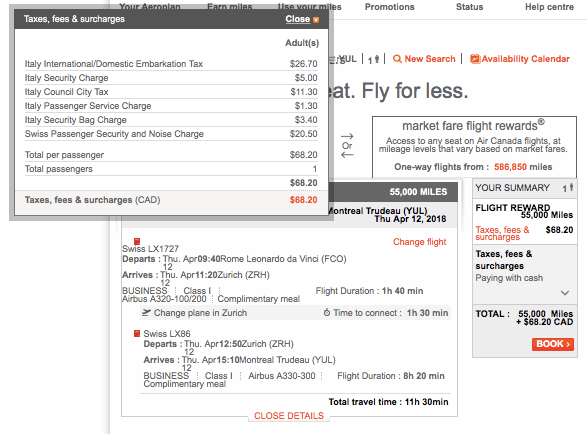

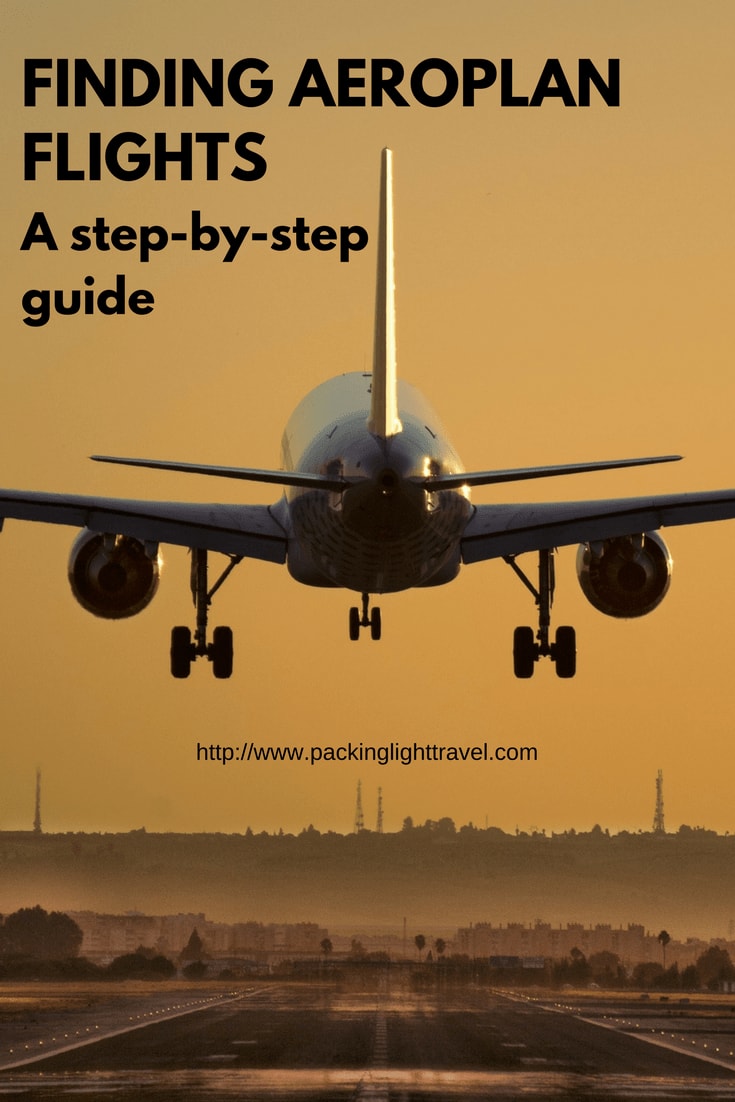




Thanks for the detail. I always do the cost benefit analysis when thinking of redeeming points (I don’t have aeroplan). This post gives me a way to think about it more intelligently.
Love all your points and tips! I feel like I need to go to school again just to learn how to book Aeroplan..it has become so confusing over the years.
want to visit our grandson in Nice from Charlottetown this fall and have been checking flights. I have had good luck with aeroplan over the years but all these options get me more confused. We are elderly and want first class.Montreal to Zurich looks tempting and maybe first choice. Can you book regular fare and buy upgrade with reward points? We can travel on any dates and probably will stay two weeks and do some touring from Nice.Any advice you can offer would be greatly appreciated.
Hello Charlotte. Yes, you can upgrade with Aeroplan. I’ve never done it myself as I suspect it represents poor value. You need to start with a fare that’s capable of being upgraded, and there are no guarantees of availability. My preference is to search for a business class redemption from the outset. Here’s Aeroplan’s link on the subject: https://www.aeroplan.com/saua/Guidelines.do
Using my guide in this post, your search would start at the end segment by finding out connections into Nice. Use FlightConnections with the Star Alliance filter checked. With your list of airlines without fuel charges close by, you’ll quickly see that SWISS has flights into Nice from Geneva and Zurich, and Brussels Airlines from Brussels. Then, check business class availability at Aeroplan (e.g., Zurich to Nice) to look for SWISS flights. Make a list of those flights within your desired window period of travel dates. Then, work on the “middle” segment: how to get to Zurich. Use FlightConnections with the Star Alliance filter set. You’ll see Toronto to Zurich but that route is served by Air Canada with obscene fuel surcharges. You’ll find Montreal to Zurich and Boston to Zurich with SWISS. Then go to Aeroplan for availability. I punched in an early October date for Boston to Zurich and found a direct SWISS flight for $7.20 in taxes/fees. (There were Lufthansa flights via Frankfurt for $697.60 in taxes, fees and surcharges!!!) Again, make a note of your options. Then, repeat the process to find the possibilities for connections from Charlotttetown to either Montreal or Boston. Expect part of that journey in economy class. Keep in mind that you can have two stopovers on a return redemption to Europe, which can be really handy for building an itinerary with your preferred flights.
I hope this helps. If you run into problems, give me a shout with your window period of preferred dates and I can see what I can find.
Arghhh…. Loved your article! But having a problem with Flight Connections. I can’t select a destination only; it wants a “from”. Yet I want to use your idea of seeing which Star Alliance airlines fly into Casablanca (in this case.) What am I missing on the website to perform this search? (PS: I’m in BC; so there should be lots of choices to avoid surcharges if I can find the right hub.)
Thanks for your help
Hi Maria. Thanks for dropping by. I’d heard FlightConnections had updated, presumably getting ready to monetize the site. I see what you mean about requiring a departure airport. This tells me I’ll be using the Star Alliance Flight Map more often. I had a quick look for a Departure Results List for Casablanca (Star Alliance Flight Map) and found 6 destinations (Cairo, EgyptAir), Frankfurt (Lufthansa), Istanbul (Turkish), Lisbon (TAP), and Montreal (Air Canada). The only airlines without fuel surcharges are Turkish, which is a fantastic carrier and EgyptAir that has mixed reviews.
If Casablanca is your destination, you’ll need to find out the Maximum Permitted Mileage from Vancouver. Travelling west from YUL will exceed the MPM, and going east via IST might also exceed the MPM. One option is explore which regional carriers serve Casablanca, and make one of those departure airports your Aeroplan destination. For example, a few years ago I used Vueling to fly from Barcelona to Marrakech to connect to an Aeroplan redemption from Halifax to Barcelona.
It’s a challenging destination, requiring some creativity to piece together an interesting itinerary and avoid those dreaded fuel surcharges. I hope this helps.
Planning on going from Toronto to Barcelona and then home from Madrid this Fall. Your article was very insightful. Not sure if I follow though – should I be looking to book 2 1-way flights or a return flight? I could also fly through Buffalo or Detroit in order to get cheaper surcharges with United.
My wife likes as direct a flight as we can get.
Any help would be appreciated.
Thanks for dropping by, Ray. You could book either two one-way flights or one open jaw. The advantages of an open-jaw booking is that you could add one stopover (there are no stopovers on one-way flights with Aeroplan). The other is that if you need to book through the Aeroplan Contact Centre, there will be just one booking fee.
Hopefully you’ll find something using United. FlightConnections is a great tool. I notice UA has direct flights from EWR and IAD to BCN, and you’ll be able to connect from YYZ without having to drive south. Now that TAP Portugal doesn’t have fuel surcharges, that should be an option from YYZ. A stopover in Lisbon could be attractive if you have the time. Good luck, and enjoy your trip.
Anne Betts recently posted…What’s the best mosque to visit in Istanbul?
I’m trying to wrap my mind around MPM… so I’m eyeing this route for next fall YYZ-CAI (or FRA)-IST-MLE-SIN-DPS-TPE-YYZ.
I did a dummy search on Aeroplan w the 3 entries being YYZ-IST / IST-DPS / DPS-YYZ
and MPM showed 16 293
Then I plugged my route into Great Circle Mapper which says there’s 12372 mi between YYZ and my first destination (MLE) and 9880 mi between my end destination (DPS) and YYZ.
Will I be okay then?
Bobbie, your destination is the furthest point of your trip where you have a stop of over 24 hours before your next flight. The allowable distance between your departure airport and your destination airport becomes your MPM. Between these two airports you can include two stopovers (longer than 24 hours) and several layovers (each up to 24 hours) as long as your total number of flight segments doesn’t exceed 16.
Once you have your MPM, each of the outbound and inbound routes can’t exceed the MPM. Although, I believe you may be able to squeeze an extra 5% but I haven’t tested this myself.
If your destination is DPS (from YYZ) you’re working with an MPM of 16,293 for each direction. Plug all possible routes, in both directions, into Great Circle Mapper to find out if you have a bookable Aeroplan itinerary. If one of your existing routes to MLE is 12,372, MLE-SIN is 2,113 and SIN-DPS is 1,037 so you should be fine staying under the outbound MPM with that routing.
You’re fine with the two segments of 2,361 (DPS-TPE) plus 7,519 (TPE-YYZ) on the inbound route. You’ve leeway to add more layovers and still stay within your inbound MPM of 16,293.
I hope this helps, and have a great trip.
How much would this entire itinerary cost in business? What are the airlines? Thanks
Thanks so much for this excellent post! I used this as my tutorial in booking a mini-RTW Aeroplan reward (Halifax to Jakarta with Amsterdam and Istanbul stopovers). It took years of saving points, over 12 hours of planning and 2 hours on the phone with Aeroplan (mostly on hold), but I got a 6 week trip to Europe and Asia for 155,000 miles and about $300 – all business class. I am sure I got better value because of your advice.
That’s fabulous Cate. Nice work, on the route, cabin class, and fees. An exciting trip indeed. Does this mean you’re from the Halifax area? If so, we could do coffee sometime if you’re interested. Also, I have some travel planner docs on both Amsterdam and Istanbul. Shoot me an email if you’d like me to send them to you. Congratulations, and have a wonderful trip.
Thanks for the insights ! I spent a couple hours last night finding the segments for my trip to Turkey in June. For the departure leg, I found the flight we wanted on Turkish Airlines in their new 787s in business class from YUL to IST. I then found an appropriate segment from YYZ to YUL to make the complete trip. This morning I called Aeroplan to speak with an agent and get their assistance to book this full trip under one points redemption. The agent ended up spelling the first name of my spouse incorrectly and issued the tickets, I noticed right away so they explained they would have to cancel the booking and rebook, they could not make the change otherwise. After cancelling the trip, those segments became unavailable in the flight inventory and I am not currently stuck without anything booked for our departure trip. Very frustrating to say the least and even more disappointing that it was their error and they could not fix the issue. Wanted to share so people are mindful in their pursuit to redeem their points!! Hopefully the flights open back up…
Goodness there was a lot of info there! Thank you! Loved all the screenshots too, super helpful. Flexibility is key, I think, to this whole thing. Just breathe and be flexible. Great article!